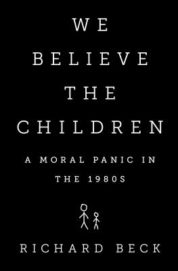 Richard Beck
Richard Beck
PublicAffairs ($26.99)
by Spencer Dew
We live in a terrifying world, shielding ourselves as best we can with fantasies that we insist, against all evidence, are true. For some, this means constructing a Manichean cosmos, a battleground between moral absolutes. For others, it means desperately clinging to a self-centered Enlightenment worldview that privileges rationality and individual liberty. Bad stuff happens, so the logic goes, and these systems offer some sense of order, salve: blame Satan or be reminded, in the words of Donald Rumsfeld, that “freedom's untidy, and free people are free to make mistakes and commit crimes and do bad things.”
How else to begin to talk about the Satanic Panic of the 1980s, or the broader moral panic, as Richard Beck terms it, surrounding outlandish tales of child abuse, many of which were linked to accounts of bizarre devil-worshipping rituals? The standard comparison is with Salem and the witch trials there, the first instance in American law wherein the testimony of children was admitted as evidence. The mass hysteria, the absurd charges, the scapegoating of citizens as part of broader social anxieties: the parallels hold, but Salem was so long ago, whereas the Satanic Panic was on 20/20, boosted by Geraldo Rivera in a noxious and illogical two hours of yellow journalism; it had its days in court in our legal system, took place under our elected government, and unfolded in our so-called secular age.
There were fringe characters, to be sure—Mike Warnke, who monetized the diabolic for an Evangelical crowd, and Lawrence Pazder, who peddled a pulp horror novel as a work of psychiatry—but the most dangerous players weren’t those actively constructing narratives of underground cultists who force children to eat feces and rape them with flagpoles. The more dangerous, more terrifying, people were those complicit in this fiction, individuals who took steps to spread lies even as they insisted we do nothing more than believe. “We believe the children,” said one social worker, “cause that’s our job and that’s, that’s what our belief is.” Or as one book written for the training of counselors puts it, “No one fantasizes abuse . . . Believe the survivor. You must believe that your client was sexually abused, even if she sometimes doubts it herself.”
Beck, an editor at n+1, homes in on this rhetoric of belief, even as he opens the archives for evidence of what this act of “believing” looked like. We’re shown a cop, for instance, twisting a child’s arm and refusing to let go until she “retracted her retraction” to being victim to a sexual act he described in detail. We see psychologists presenting erroneous data in order to bolster the delusion of recovered memory therapy. We see counselors and therapists, proclaiming themselves allies to the children, the victims, victimizing them. “Are you going to be stupid, or are you going to be smart and help us here?” one child was asked by an investigator. With no accusation forthcoming from the interview, the child is told “Well, what good are you? You must be dumb.”
The panic is well-trod ground for non-dumb people intrigued and horrified by this modern-day witch-hunt, and has been covered in books from Jeffrey Victor’s Satanic Panic: The Creation of a Contemporary Legend (1993) to Lawrence Wright’s Remembering Satan: A Tragic Case of Recovered Memories (1994) to Elaine Showalter’s Hystories: Hysterical Epidemics and Modern Media (1997). Beck’s book is a reboot for the contemporary audience, many of whom are too young to remember the events described. His thesis is pointed: the moral panic is what the women’s movement, the sexual revolution, and the reordering of the family wrought. In Reagan’s crumbling economy, with women entering the workforce and, thus, children in daycare, the moral panic was a manifestation of anti-feminism and anti-homosexuality, of anxiety about traditional norms. “The day care trials were a powerful instrument of the decade’s resurgent sexual conservatism, serving as a warning to mothers who thought they could keep their very young children safe while simultaneously pursuing a life outside the home.”
Beck’s argument helps explain the odd bedfellows of the believe the children movement; Anita Bryant, who hoped to ban homosexuals as school teachers, found herself on the same side as Andrea Dworkin, who hoped to ban anything that might fall under the category of pornography. In the panic, all manner of ideologies could be read as leading in the same direction, to the same satisfying purge, the same ravenous commitment to the idea of pure victimization. Indeed, the moral panic was as much a kind of moral nostalgia, apocalyptic desires on play in detailed narratives about evil inflicted on the most innocent of all.
The material alone is so frightening, so demanding of attention and analysis, that it is almost beside the point to criticize Beck’s book for repetition or moments of sag. As we enter another era of paranoid politics, of mass anxiety, and of mainstream discourse scapegoating certain groups—Muslims, Mexicans, transgender folks—serious consideration of the Satanic Panic feels increasingly important, even if such consideration also inspires deep foreboding.
